It’s spring here in the Southern Hemisphere. Why am I talking about tarot decks for Samhain and ancestor communication?
All my Sabbats are a happy mess. Although I am glad to gather with friends and acquaintances and attend public rituals, I’m a solitary Witch in Australia, quietly observing Sabbats privately. My coven and Goddess Temple are in the U.S., and I celebrate Esbats and Sabbats with them too. So, I celebrate two Sabbats at every turn of the Wheel.
Australians don’t celebrate Halloween as much as Americans, but the holiday is growing more popular, at least in my little corner of Melbourne. Day of the Dead celebrations are also popular. In a couple of weeks, I’ll celebrate Samhain with my coven. Plus, I dedicate the month of October to Hecate and revisiting the research into my ancestors. So, even though it’s spring, daylight savings, and I’m waking up to the sounds of squawking birds, the feelings of Samhain is with me.
One of the biggest #FirstWorldProblems for tarot enthusiasts is having too many decks and insufficient time or opportunities to use them. I rotate my decks and typically use one or two a month, but lately, I’ve been using more decks and exploring tarot for ancestral work. Here are, at present, my favourite tarot decks for Samhain and ancestor communication.
The Rider-Waite-Smith Tarot
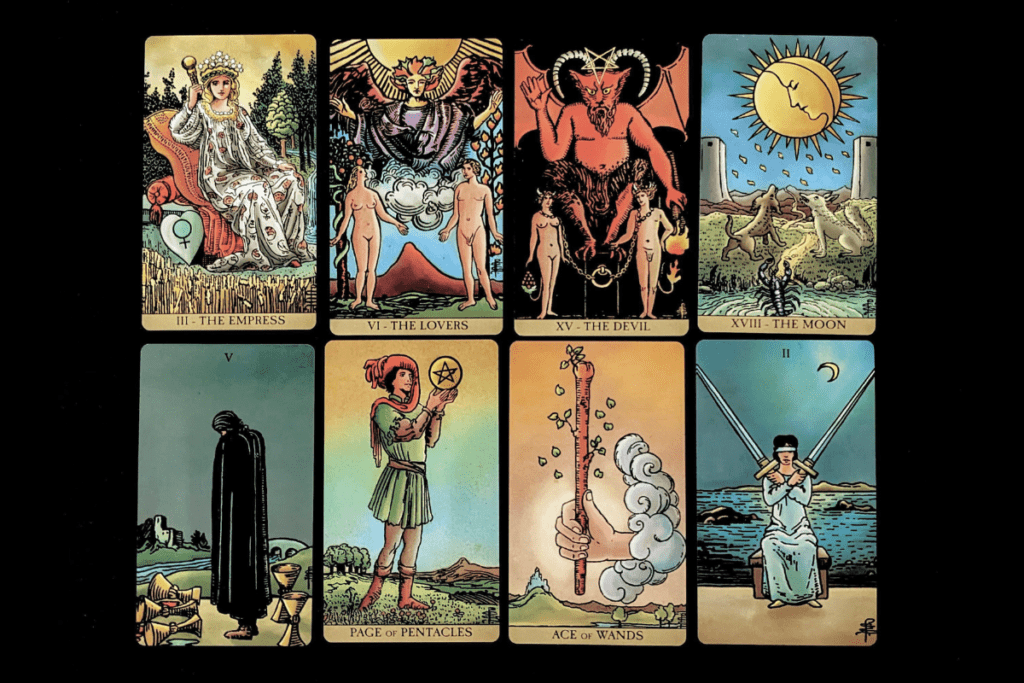
I have about 20 Rider-Waite-Smith (RWS) decks in my modest tarot collection. It was my first tarot deck and remained my sentimental favourite, most collected, and most used.
I recommend it to anyone interested in tarot. The RWS is a great tarot deck for beginners because it sets the standard in imagery and meanings for many decks after it, and there are many resources to help you learn. More experienced readers can dive deeper into it and explore its occult associations.
I have a new favourite RWS every few months (or weeks or days). Currently, my favourite is the sixth edition of a Yellow Box deck from the 1970s made in Switzerland for U.S. Games, which lacks the copyright and ISBN. It is a version referred to as the Sunburnt Magician because the Magician card on the cover of the box looks like he has a sunburn. The cards have a beautiful buttery feel to them. However, at the moment, my go-to deck is the Radiant Wise Spirit Tarot by Lo Scarabeo, shown here. It’s my favourite of all the modern, brighter versions of the RWS, and I love the borderless edges.
There’s nothing special about the RWS for Samhain or ancestor communication. The RWS is a classic tarot deck that goes with everything.
Samhain Deck of the Bastard by Tarot By Seven
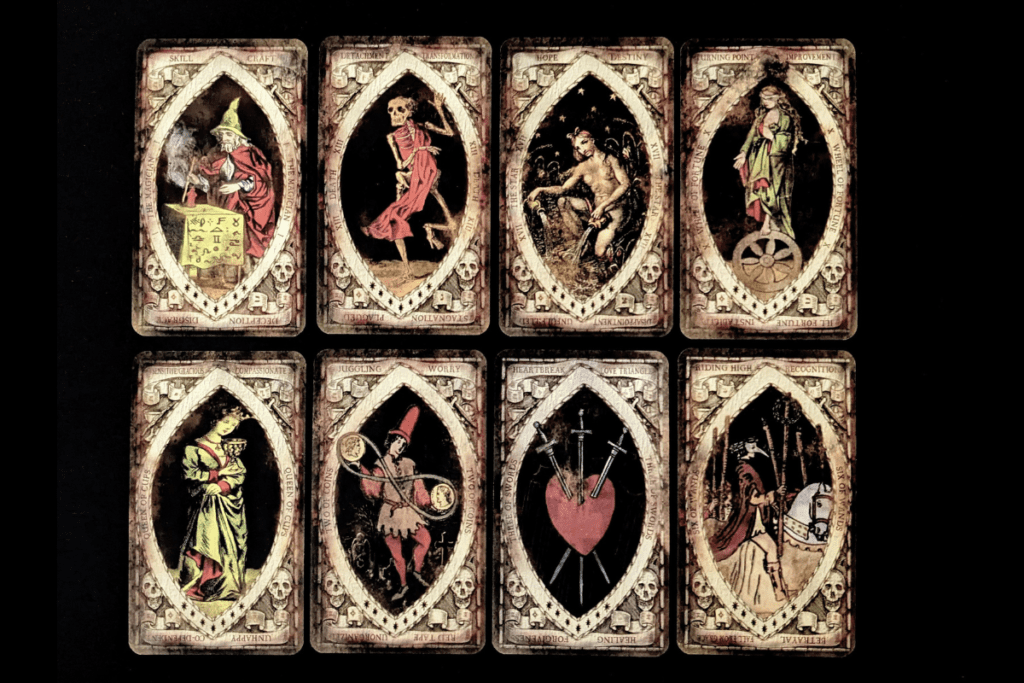
Tarot By Seven specialises in custom decks. The Deck of the Bastard gets its name from combining images from several decks, namely the RWS and Etteilla, and has the creator’s flourishes. The Samhain version has a black background and other Gothic elements.
I love this deck because it feels like a fully illustrated historical deck without the fragility and price ticket of one. With its darker aesthetic, it’s beautiful, interesting, creative, comfortable in my hands and smooth to shuffle. You can opt to add keywords to the cards.
My version, shown here, is the second edition from about 2014. The current Samhain Deck of the Bastard, dubbed ‘The Dearly Departed Bastard’, is slightly different.
Visit Tarot by Seven.
The Relative Tarot by Carrie Paris
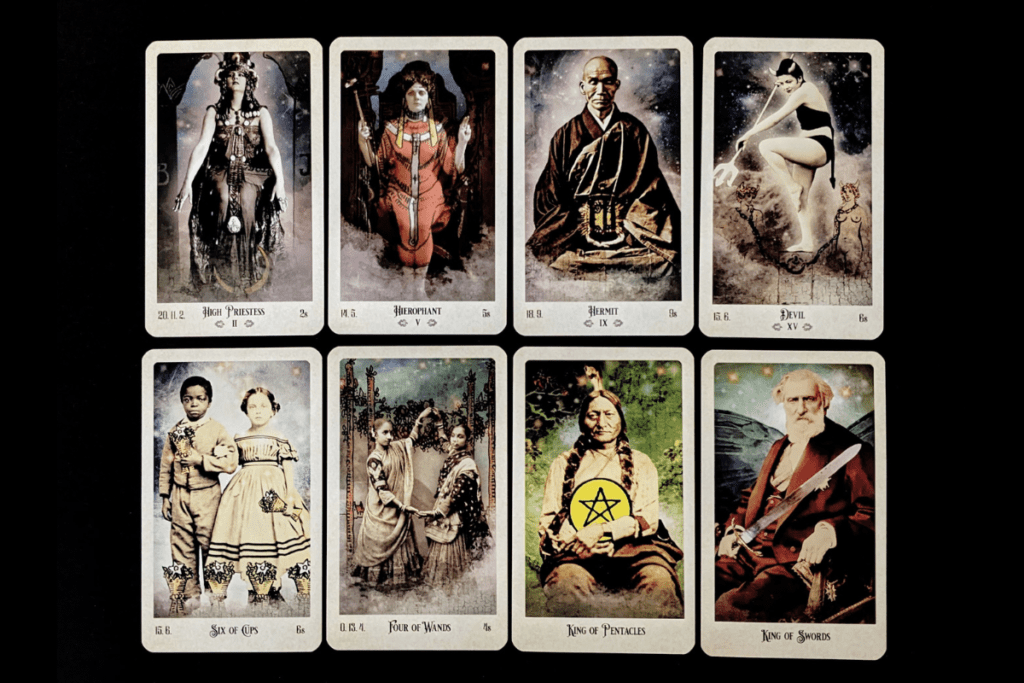
The Relative Tarot by Carrie Paris was a 2019 Kickstarter but is now available from Weiser Books. I didn’t back the Kickstarter because I was undecided about this tarot for a long time. I’m not generally a fan of photography, collage, and mixed media tarot decks, and I wasn’t sure about it when I ordered it. I was sceptical about how well it would serve me as a deck for ancestral work. Would I be able to connect with the figures in the cards? But I fell in love with it once I had it in my hands.
The Relative Tarot is a beautiful sepia-toned deck with gilded edges that features vintage 19th-century photographs combined with familiar RWS tarot illustrations (though you can apply the Marseille reading system). Paris made the Relative Tarot with her fans’ portraits of their relatives. The result is a diverse and inclusive tarot deck. As I flip through the cards, I can’t help but wonder who the people are and what their stories are.
The 94-page booklet that comes with the Relative Tarot is interesting too. Rather than list keywords or meanings, the Guidebook for the Diligent Diviner teaches readers how to cast their Tarot Blueprint based on the concepts of birth, annual, significator, and soul expression cards. Every card has corresponding numbers.
The Relative Tarot shines as a deck for self-development, and this is among the favourite tarot decks of my inner Jungian student.
Visit Carrie Paris.
The Herbcrafter's Tarot by Joanna Powell Colbert and Latisha Guthrie
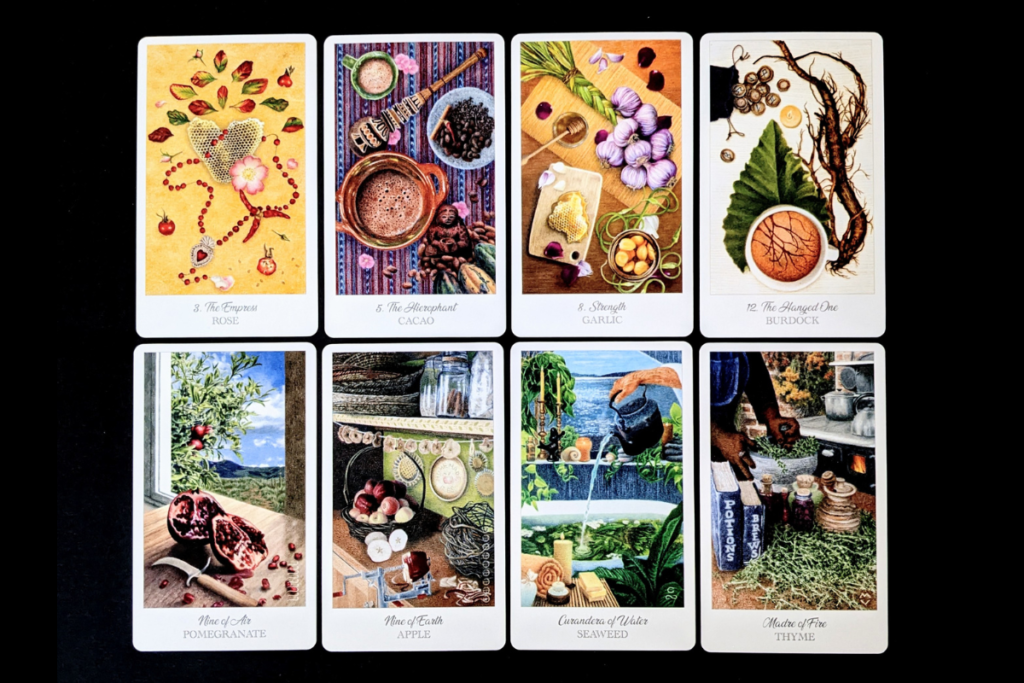
The Herbcrafter’s Tarot is another deck I’d typically say isn’t my style. I’ve never been interested in botanicals and green witchcraft, but this deck is exceptional.
This beautiful 78-card tarot deck features, you guessed it, plants. The Major Arcana follows the herbcrafter’s journey. The Minor Arcana are named after the elements (e.g. Water instead of Cups) and uses herbcrafter’s tools instead of the traditional suits (e.g. a bolline instead of a sword). Every plant is assigned to its suit based on its medicine and organised by pip. For example, all the Fives are threatened or endangered.
The 16 court cards show hands–the hands of women, our ancestral medicine keepers. These are hedge witches, grandmothers, and midwives. The Pages are Hijas (daughters), the Knights are Adelitas (Warriors), the Queens are Madres (mothers), and the Kings are Curanderas (healers).
The 123-page booklet is like a little herbal grimoire. It contains a surprising amount of information about each plant, how to use the deck, a few spreads, and even instructions on making cordials, salves, tinctures, and more. This deck isn’t just about plants but also our human connection to them. A lot of thought and research went into this deck, and the result is beautiful.
Despite my lack of knowledge about plants and botanicals, the Herbcrafter’s Tarot feels familiar, like a grandmother’s kitchen from centuries ago. Although the cards draw on Mexican culture and language (I’m Cuban, and it’s not the same), I appreciate that the titles of the court cards are in Spanish.
The Herbcrafter’s Tarot is a warm, wonderful deck that celebrates women’s crafts and skills and is an excellent choice for ancestral work.
Visit herbcrafterstarot.com.
The Orisha Tarot by Andrew McGregor, Obatilemi
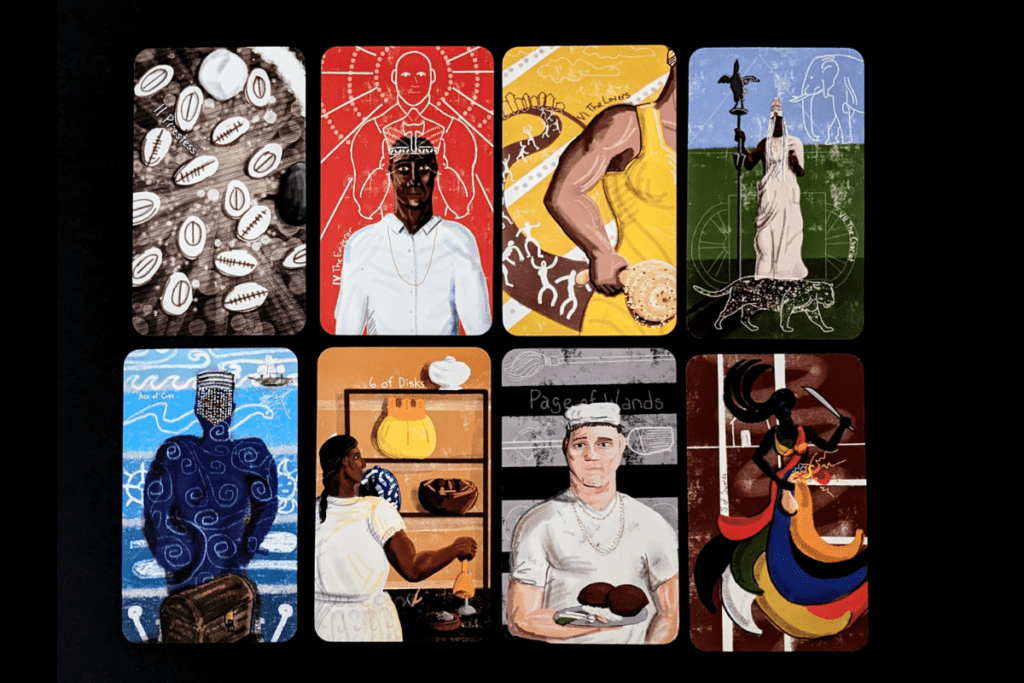
The Orisha Tarot is not the only deck of its kind, but it’s the only one I’ve ever wanted.
Andrew McGregor has a background in ceremonial magick and has been working with the tarot for many years; he’s the owner of the Hermit’s Lamp in Toronto. He is also a priest in Lukumi, an Afro-Cuban religion. He understands the potential, challenges, limitations, and boundaries of bringing together the stories and symbolism of Lukumi and tarot, which is not a traditional part of the religion.
McGregor has created a thoughtful and meaningful deck. The Major Arcana focuses on cosmology, and the Minor Arcana on patakis (stories). The court cards depict practitioners, such as a priest or a drummer. The beautiful companion book is 354 colour pages and contains a 1-2 page description of every card. The cards are borderless, which I love, and the titles are a subtle part of the art.
According to Lukumi tradition, the orishas do not speak through the tarot; they talk through the cowrie shells, and only a specially trained priest reads them. But the Orisha Tarot is an accessible way to learn more about the religion and refer to its stories to gain insight and find solutions. I also find it’s a great tarot deck for ancestral work.
Visit thehermitslamp.com.
Baraja española by Fournier
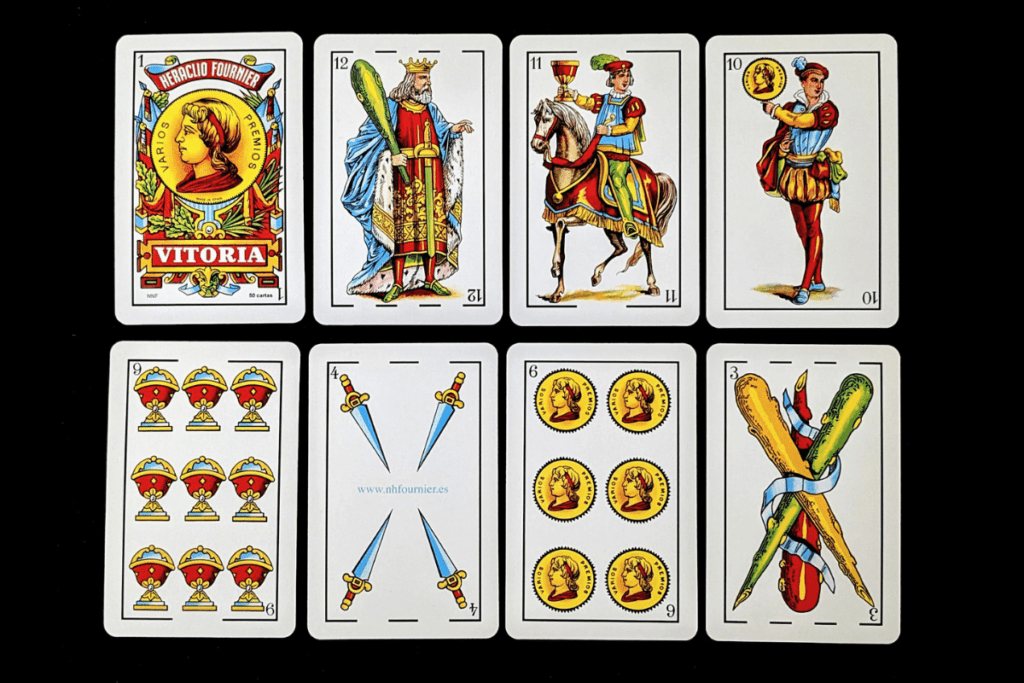
In Spanish-speaking countries, the preferred deck for cartomancy is not the tarot but la baraja española, Spanish-suited playing cards.
There are different patterns and decks printed and published by various companies, but the most widespread is the Castillian pattern designed and published by Heraclio Fournier in 1889. There are four variants in the number of cards: 40, 43, 50, and 55. La baraja española I’m familiar with has 50 cards, including two jokers not used in divination. There are four suits: swords, cups, coins, and clubs. Each suit contains 12 cards: ace through nine, knave (10), knight (11), and king (12).
People play card games with these, but I know la baraja española as the preferred deck of the Cuban espiritista (spiritualist). So, although it’s not a tarot, it makes the list for being an ancestral deck.
Visit Fournier.
The Mythic Tarot by Juliet Sharman-Burke
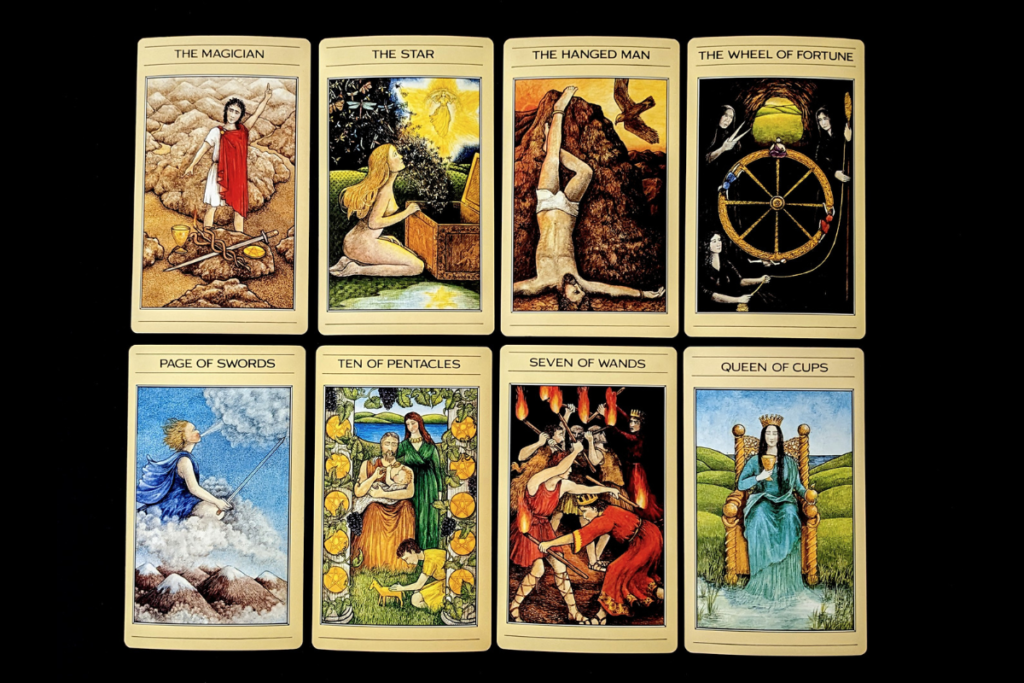
The Mythic Tarot is not one of my ancestral decks, but it’s a deck I use a lot in October. I devote this month to Hecate, and I’ve dedicated the Mythic Tarot to her.
The unnumbered Major Arcana depicts the gods. For example, Persephone is the High Priestess, Hecate is the Moon, and Iris, the rainbow goddess, is Temperance. The Lovers shows the Judgement of Paris, the Star is Pandora, and the Tower depicts Poseidon striking down the labyrinth of King Minos.
Each suite of the Minor Arcana depicts a Greek myth:
- Swords: the Oresteia
- Wands: Jason and the Golden Fleece
- Cups: Eros and Psyche
- Pentacles: Daedalus
The Mythic Tarot is based on the RWS system, but sections of the myths don’t always align with traditional meanings. I think that’s fine; many tarot readers draw on various sources to interpret the cards.
Note that the deck shown here is old and has the original artwork. Reprints are different. If you don’t have this deck and are considering getting it, do a little research and compare the art.
Those are my favourite tarot decks for Samhain and ancestor communication.
Of course, many other tarot and oracle decks would be great for Samhain and ancestor communication. These decks reflect my tastes, devotional practice, and ancestry.
You may prefer a more Romantic deck like the Bohemian Gothic Tarot or something more whimsical like Disney’s Hocus Pocus, Villains, and Nightmare Before Christmas tarot decks. The Seasons of the Witch: Samhain Oracle, Stacey Demarco’s Halloween Oracle, and Karin Lee’s Halloween Tarot remain popular choices this time of year.
For ancestor communication, a deck like the Relative Tarot is excellent, and I also recommend you look for a deck that reflects your ancestry. If you have Slavic ancestors, you might enjoy the beautiful Tarot of the Golden Wheel or the Vikings Tarot if your ancestor hail from northern Europe.
Do you have special decks for the season or ancestor work?

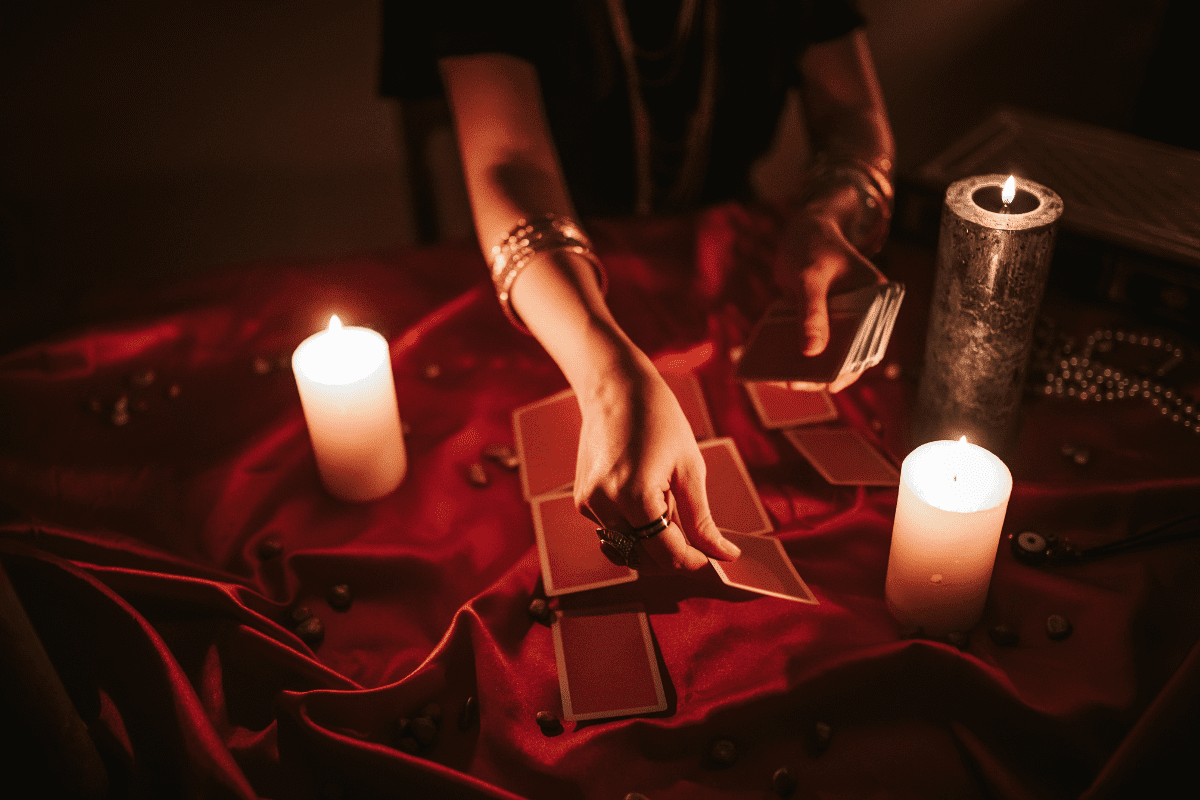
The Relative Tarot has been a good deck for me!
I’m glad to hear that! It’s a gorgeous and really interesting deck.